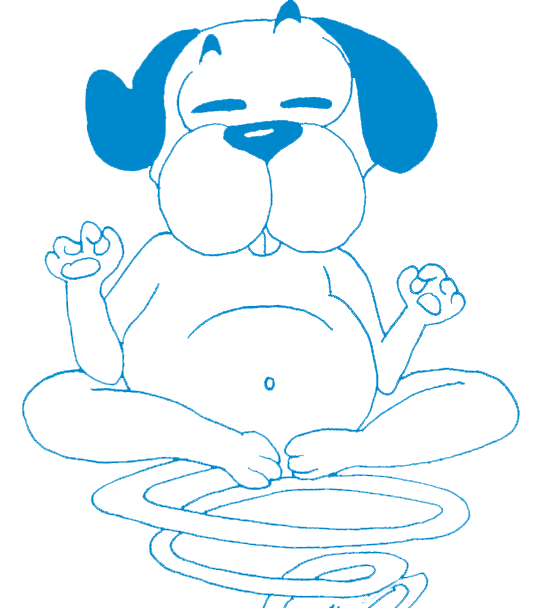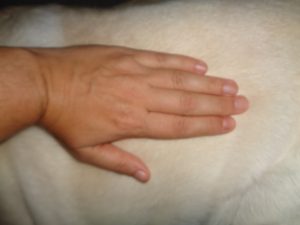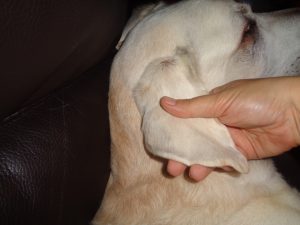The foundations
Recommended book: The complete dog massage manual – Gentle dog care by Julia Robertson
Before any handling, let’s take the time to check that our dog really wants to be touched, stroked or massaged. A dog that appreciates being stroked in a general way, may not feel like being stroked at a specific time of the day or week (excitement, fatigue, pain, thirst, needs,…). If our dog is forced (by physically restraining him or by giving him the order to stay for example), the caressing or massaging session will not bring him any benefit.
Some dogs will appreciate a simple contact, such as placing the back or palm of the hand, fingers relaxed, without moving.
Let’s provide a comfortable place for our dog: a quiet room and a mattress or blanket. The bedding (mattress or blanket) will be the place reserved for the sessions. If our dog wishes to take a break, he will only have to leave the bedding area. It is up to us to respect his limits and his wishes.
The massages are always done in the direction of the fur and the muscles, leaving one hand in contact at all times (static, placed outside the area of the body that is being massaged). We can also use both hands in movement, taking care that one hand remains in constant contact with the dog. Be aware that two hands in motion is not recommended for nervous dogs. For small dogs, we can use two fingers instead of the whole hand (index and middle fingers).
Once the session has started, let’s remember to give him the opportunity to take a break and leave: we just have to take our hands off and observe our dog’s reactions for 5 seconds. Using his body language, postures or attitudes, he will tell us if he wants the session to continue, end or if a short break is necessary.
If they do not wish to be petted, some dogs will simply back off as soon as they understand our intention. Others, will be more nuanced and show calming signals such as:
- freezing,
- turning the head,
- licking,
- yawning,
- blinking,…
Respecting his personal space
While humans hug and kiss all the time, dogs don’t do this. This closeness is far too intrusive for a dog; the lack of freedom of movement that a “big hug” represents may make our dog feel uncomfortable. Most dogs learn to tolerate these invasions and rudeness from the humans in their family, but that doesn’t mean they find it pleasant or comfortable.
How to start
The easiest technique to learn is that of effleurage: the hand flat, fingers together, with light pressure. Our dog will tell us if the pressure should be lighter or more pronounced. It looks like a caress, but the intention is different: let’s focus on what our hand feels. What information do we receive via the palm of our hand? Do we feel warmth, knotted or supple muscles, tension in our dog’s body?
Here’s how to proceed:
- We will sit near the massage area (bedding such as a mattress or blanket);
![]() Video: Inviting Fripouille for a massage
Video: Inviting Fripouille for a massage
- We sit or kneel next to our dog (do not lean over or face him);
- Place the palm of one hand on our dog, and let it rest to make contact;
- Let us place the second hand, palm on the shoulder, and in a gentle way, making slow and calm gestures, slide our hand from the shoulders to the side, following the direction of the fur and muscles (3x on each side);
- We can also use both hands, one after the other (only one hand is preferable for a nervous dog);
- During the session, we must remain mindful of our body position in relation to our dog and avoid leaning over him at all times (let’s only caress the flank which is on our side);
- Let’s pause to check that our dog still wants to be stroked (5 seconds);
- Let’s give him the choice to leave at any time;
- Then let’s move from the top of the shoulder to the chest (3x on each side);
![]() Video: From the neck to the shoulder and from the shoulder to the chest
Video: From the neck to the shoulder and from the shoulder to the chest
- Go back to the top of the shoulder and follow the spine backwards (not on the spine, but just beside it) (3x on each side);
- Let’s check that our dog still wants to be stroked;
- Let’s go to the neck, positioning our hand behind his ear and sliding our hand down to the shoulder (3x on each side);
- We can also massage the thighs: be careful to support the knee joint with one hand, while the surface of the thigh is stroked with the other hand.
If our dog is ready to continue, we can offer him an ear massage: the ear supported by the fingers of the hand and smoothed by the thumb, by slow movements, in the direction of the fur (from the top of the ear to the edge).
|
|
|
The benefits
It has been proven that appropriate stroking can lower the dog’s heart rate. The dog is relaxed and feels the experience in a positive way.
Massage positively affects the lymphatic and circulatory systems to promote healing. Remember that the veins carry blood with metabolic waste, while the arteries carry oxygenated blood. If the muscle is blocked by a knot or tension, it is loaded with venous blood (waste products) that has not been able to circulate properly. By stretching the muscle, arterial blood (oxygen) is supplied to nourish and repair the muscles.
Massages lead to the release of oxytocin. This is a neurotransmitter that acts on the limbic system, the emotional centre of the brain, promoting a feeling of satisfaction and reducing anxiety and stress. During a massage, both the person massaging and the one who is being massaged experience a release of this wellness hormone. The massage stimulates the brain to produce dopamine and releases endorphins and serotonin into the blood vessels which improve mood and promote happiness.
Massaging the muscles reduces muscle spasms, cramps and adhesions. It also prevents dysfunctions of the muscles and fascia (connective tissue that surrounds the muscles as well as nerves, bones, blood vessels,…).
Massages are of course known for their relaxing effects, both physiologically and psychologically.
By respecting our dog’s wishes (giving him the choice to end the massage, adapting the pressure to his needs, massaging the areas according to his indications,…), the relationship between our dog and us can only grow.
When NOT to massage
- Within two hours before and after meals,
- When the dog is sick (dehydrated, fever, swollen lymph glands, …),
- When the dog is injured (open wound, infected skin, …),
- When he is tired or breathes heavily,
- Un case of clinical shock,
- Immediately after an accident or impact,
- In case of persistent pain (without diagnosis),
- If the dog has a lump, growth or tumor,
- If the dog does not want a massage.
![]() Video: When Koumack does not want a massage
Video: When Koumack does not want a massage
TAKEAWAY
- It is up to us to observe and understand what our dog likes;
- Massage on a specific area (mattress or blanket) that our dog can leave if necessary;
- Adapt the massage ( areas, pressure,…) depending on our dog’s reactions;
- Mind the counter-indications.
 Activities for happy dogs
Activities for happy dogs


